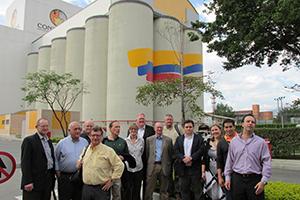Last week, officers of the U.S. Grains Council and National Corn Growers Association wrapped-up an almost two-week trip to Colombia and Mexico. They met with key customers and end-users who were excited host the joint-officers and discuss further deepening the already robust trade partnership with the United States.
Mexico is leading the world as the top U.S. corn export customer with accumulated exports of more than 5.7 million metric tons (224 million bushels) from Sept. 1, 2013, through March 27, 2014, an increase of 250 percent over the same time period last year. Additionally, Colombia is making a comeback as a regular buyer of U.S. corn, with accumulated exports totalling more than 1.7 million tons (66 million bushels) from Sept. 1, 2013, to March 27, 2014.
USGC Chairman Julius Schaaf conducted a brief Q&A about the success of the trip:
What was your biggest take-away from the trip?
With Mexico the leading U.S. corn export customer and Colombia on the rebound, it’s important that we pay even closer attention to these reliable markets close to home. We need to take care of our neighbors and continue to build on long-term relationships. Mexico has an advanced economy, sophisticated agricultural businesses and is on the cutting-edge of technology. Both Mexico and Colombia are predictable and transparent grain trading partners for the United States and a great example for other parts of the world.
What’s the biggest challenge to exporting grain to Mexico and Colombia?
Currently, it’s infrastructure. The on-going rail car shortage is tying-up grain shipments to Mexico. Solving logistics and infrastructure issues for exporting and improving rail car availability would go a long way toward ensuring deliveries to both countries. Bad weather this winter has contributed to the problem, but the fact that we have an aging infrastructure and are underinvesting in maintenance and upgrades is a big factor too.
Are there new opportunities in Mexico?
The sky’s the limit in Mexico. It’s the third most-populous country in the Americas, has a relatively young, educated and growing population – the average age is 26 – and a growing middle class. The United States already enjoys a high market share due to our logistical advantage, but Mexico will continue to grow. There are interesting opportunities to expand exports of DDGS and yellow corn.
How is biotechnology viewed in Mexico and Colombia?
From a trade standpoint, Mexico has been an exceptional partner with respect to enabling the trade of grains derived from biotechnology. It becomes a sensitive issue in Mexico from an environmental standpoint because the country is the “center of origin” for corn. Despite the fact that their ancestors are responsible for creating the corn we know today from the original teosinte, farmers in Mexico are denied the economic and environmental benefits of the more recent developments in corn seed technology.
In Colombia, we see a country taking positive steps in both enabling its farmers to access biotech crops and also better facilitating the import of grains derived from biotechnology. The Council is working closely with Colombia to develop a trade-promoting low-level presence policy that could be a benchmark for other importing countries; we’ve been encouraged by the progress.


